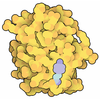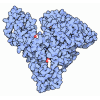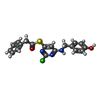[English] 日本語
 Yorodumi
Yorodumi- PDB-7t2x: Estrogen Receptor Alpha Ligand Binding Domain Y537S in Complex wi... -
+ Open data
Open data
- Basic information
Basic information
| Entry | Database: PDB / ID: 7t2x | ||||||
|---|---|---|---|---|---|---|---|
| Title | Estrogen Receptor Alpha Ligand Binding Domain Y537S in Complex with 2-chloro-4-((4-hydroxybenzyl)amino)-5-phenylthieno[2,3-d]pyrimidin-6-ol and GRIP Peptide | ||||||
 Components Components |
| ||||||
 Keywords Keywords | TRANSCRIPTION / Estrogen Receptor / Hormone Agonist / Alpha Helical Bundle | ||||||
| Function / homology |  Function and homology information Function and homology informationregulation of epithelial cell apoptotic process / antral ovarian follicle growth / RNA polymerase II intronic transcription regulatory region sequence-specific DNA binding / regulation of branching involved in prostate gland morphogenesis / RUNX1 regulates transcription of genes involved in WNT signaling / RUNX1 regulates estrogen receptor mediated transcription / regulation of toll-like receptor signaling pathway / nuclear estrogen receptor activity / epithelial cell development / steroid hormone receptor signaling pathway ...regulation of epithelial cell apoptotic process / antral ovarian follicle growth / RNA polymerase II intronic transcription regulatory region sequence-specific DNA binding / regulation of branching involved in prostate gland morphogenesis / RUNX1 regulates transcription of genes involved in WNT signaling / RUNX1 regulates estrogen receptor mediated transcription / regulation of toll-like receptor signaling pathway / nuclear estrogen receptor activity / epithelial cell development / steroid hormone receptor signaling pathway / epithelial cell proliferation involved in mammary gland duct elongation / prostate epithelial cord elongation / prostate epithelial cord arborization involved in prostate glandular acinus morphogenesis / locomotor rhythm / mammary gland branching involved in pregnancy / negative regulation of smooth muscle cell apoptotic process / uterus development / aryl hydrocarbon receptor binding / vagina development / TFIIB-class transcription factor binding / cellular response to Thyroglobulin triiodothyronine / regulation of lipid metabolic process / androgen metabolic process / regulation of glucose metabolic process / Synthesis of bile acids and bile salts / mammary gland alveolus development / cellular response to estrogen stimulus / estrogen response element binding / Synthesis of bile acids and bile salts via 27-hydroxycholesterol / Endogenous sterols / Synthesis of bile acids and bile salts via 7alpha-hydroxycholesterol / Mitochondrial unfolded protein response (UPRmt) / nuclear receptor-mediated steroid hormone signaling pathway / positive regulation of DNA-binding transcription factor activity / negative regulation of DNA-binding transcription factor activity / Nuclear signaling by ERBB4 / cellular response to hormone stimulus / Recycling of bile acids and salts / transcription regulator inhibitor activity / RNA polymerase II preinitiation complex assembly / positive regulation of nitric-oxide synthase activity / estrogen receptor signaling pathway / protein localization to chromatin / positive regulation of adipose tissue development / steroid binding / : / 14-3-3 protein binding / Regulation of lipid metabolism by PPARalpha / peroxisome proliferator activated receptor signaling pathway / negative regulation of canonical NF-kappaB signal transduction / TFAP2 (AP-2) family regulates transcription of growth factors and their receptors / regulation of cellular response to insulin stimulus / BMAL1:CLOCK,NPAS2 activates circadian expression / negative regulation of miRNA transcription / SUMOylation of transcription cofactors / response to progesterone / Activation of gene expression by SREBF (SREBP) / ESR-mediated signaling / TBP-class protein binding / nitric-oxide synthase regulator activity / nuclear estrogen receptor binding / transcription coregulator binding / nuclear receptor binding / transcription corepressor binding / negative regulation of smoothened signaling pathway / stem cell differentiation / SUMOylation of intracellular receptors / mRNA transcription by RNA polymerase II / cellular response to estradiol stimulus / circadian regulation of gene expression / Heme signaling / Transcriptional activation of mitochondrial biogenesis / euchromatin / PPARA activates gene expression / Activated PKN1 stimulates transcription of AR (androgen receptor) regulated genes KLK2 and KLK3 / Cytoprotection by HMOX1 / beta-catenin binding / Transcriptional regulation of white adipocyte differentiation / Nuclear Receptor transcription pathway / RNA polymerase II transcription regulator complex / response to estrogen / Regulation of RUNX2 expression and activity / transcription coactivator binding / male gonad development / nuclear receptor activity / Ovarian tumor domain proteases / : / positive regulation of fibroblast proliferation / Constitutive Signaling by Aberrant PI3K in Cancer / positive regulation of nitric oxide biosynthetic process / sequence-specific double-stranded DNA binding / response to estradiol / PIP3 activates AKT signaling / HATs acetylate histones / positive regulation of cytosolic calcium ion concentration / MLL4 and MLL3 complexes regulate expression of PPARG target genes in adipogenesis and hepatic steatosis / ATPase binding / PI5P, PP2A and IER3 Regulate PI3K/AKT Signaling / regulation of inflammatory response / DNA-binding transcription activator activity, RNA polymerase II-specific Similarity search - Function | ||||||
| Biological species |  Homo sapiens (human) Homo sapiens (human) | ||||||
| Method |  X-RAY DIFFRACTION / X-RAY DIFFRACTION /  SYNCHROTRON / SYNCHROTRON /  MOLECULAR REPLACEMENT / Resolution: 2.6 Å MOLECULAR REPLACEMENT / Resolution: 2.6 Å | ||||||
 Authors Authors | Joiner, C. / Sammeta, V.K.R. / Norris, J.D. / McDonnell, D.P. / Wilson, T.M. / Fanning, S.W. | ||||||
| Funding support | 1items
| ||||||
 Citation Citation |  Journal: Acs Med.Chem.Lett. / Year: 2022 Journal: Acs Med.Chem.Lett. / Year: 2022Title: A New Chemotype of Chemically Tractable Nonsteroidal Estrogens Based on a Thieno[2,3- d ]pyrimidine Core. Authors: Sammeta, V.R. / Norris, J.D. / Artham, S. / Torrice, C.D. / Byemerwa, J. / Joiner, C. / Fanning, S.W. / McDonnell, D.P. / Willson, T.M. | ||||||
| History |
|
- Structure visualization
Structure visualization
| Structure viewer | Molecule:  Molmil Molmil Jmol/JSmol Jmol/JSmol |
|---|
- Downloads & links
Downloads & links
- Download
Download
| PDBx/mmCIF format |  7t2x.cif.gz 7t2x.cif.gz | 105.7 KB | Display |  PDBx/mmCIF format PDBx/mmCIF format |
|---|---|---|---|---|
| PDB format |  pdb7t2x.ent.gz pdb7t2x.ent.gz | 77.8 KB | Display |  PDB format PDB format |
| PDBx/mmJSON format |  7t2x.json.gz 7t2x.json.gz | Tree view |  PDBx/mmJSON format PDBx/mmJSON format | |
| Others |  Other downloads Other downloads |
-Validation report
| Summary document |  7t2x_validation.pdf.gz 7t2x_validation.pdf.gz | 1.1 MB | Display |  wwPDB validaton report wwPDB validaton report |
|---|---|---|---|---|
| Full document |  7t2x_full_validation.pdf.gz 7t2x_full_validation.pdf.gz | 1.1 MB | Display | |
| Data in XML |  7t2x_validation.xml.gz 7t2x_validation.xml.gz | 20.6 KB | Display | |
| Data in CIF |  7t2x_validation.cif.gz 7t2x_validation.cif.gz | 26.8 KB | Display | |
| Arichive directory |  https://data.pdbj.org/pub/pdb/validation_reports/t2/7t2x https://data.pdbj.org/pub/pdb/validation_reports/t2/7t2x ftp://data.pdbj.org/pub/pdb/validation_reports/t2/7t2x ftp://data.pdbj.org/pub/pdb/validation_reports/t2/7t2x | HTTPS FTP |
-Related structure data
| Related structure data | 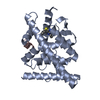 7rkeSC S: Starting model for refinement C: citing same article ( |
|---|---|
| Similar structure data | Similarity search - Function & homology  F&H Search F&H Search |
- Links
Links
- Assembly
Assembly
| Deposited unit | 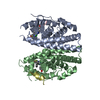
| ||||||||
|---|---|---|---|---|---|---|---|---|---|
| 1 | 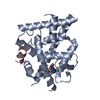
| ||||||||
| 2 | 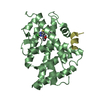
| ||||||||
| Unit cell |
|
- Components
Components
| #1: Protein | Mass: 29774.123 Da / Num. of mol.: 2 / Mutation: Y537S Source method: isolated from a genetically manipulated source Source: (gene. exp.)  Homo sapiens (human) / Gene: ESR1, ESR, NR3A1 / Production host: Homo sapiens (human) / Gene: ESR1, ESR, NR3A1 / Production host:  #2: Protein/peptide | Mass: 1579.866 Da / Num. of mol.: 2 Source method: isolated from a genetically manipulated source Source: (gene. exp.)  Homo sapiens (human) / Gene: NCOA2, BHLHE75, SRC2, TIF2 / Production host: synthetic construct (others) / References: UniProt: Q15596 Homo sapiens (human) / Gene: NCOA2, BHLHE75, SRC2, TIF2 / Production host: synthetic construct (others) / References: UniProt: Q15596#3: Chemical | #4: Water | ChemComp-HOH / | Has ligand of interest | Y | |
|---|
-Experimental details
-Experiment
| Experiment | Method:  X-RAY DIFFRACTION / Number of used crystals: 1 X-RAY DIFFRACTION / Number of used crystals: 1 |
|---|
- Sample preparation
Sample preparation
| Crystal | Density Matthews: 2.09 Å3/Da / Density % sol: 41.13 % |
|---|---|
| Crystal grow | Temperature: 298 K / Method: vapor diffusion, hanging drop / Details: PEG 3,350, MgCl2, HEPES pH 8 |
-Data collection
| Diffraction | Mean temperature: 100 K / Serial crystal experiment: N |
|---|---|
| Diffraction source | Source:  SYNCHROTRON / Site: SYNCHROTRON / Site:  APS APS  / Beamline: 19-BM / Wavelength: 0.97 Å / Beamline: 19-BM / Wavelength: 0.97 Å |
| Detector | Type: ADSC QUANTUM 315r / Detector: CCD / Date: Sep 28, 2021 |
| Radiation | Protocol: SINGLE WAVELENGTH / Monochromatic (M) / Laue (L): M / Scattering type: x-ray |
| Radiation wavelength | Wavelength: 0.97 Å / Relative weight: 1 |
| Reflection | Resolution: 2.4→50 Å / Num. obs: 13369 / % possible obs: 97.8 % / Redundancy: 3.6 % / CC1/2: 0.997 / Net I/σ(I): 7.73 |
| Reflection shell | Resolution: 2.4→2.44 Å / Num. unique obs: 1702 / CC1/2: 0.667 |
- Processing
Processing
| Software |
| ||||||||||||||||||||||||||||||||||||||||||
|---|---|---|---|---|---|---|---|---|---|---|---|---|---|---|---|---|---|---|---|---|---|---|---|---|---|---|---|---|---|---|---|---|---|---|---|---|---|---|---|---|---|---|---|
| Refinement | Method to determine structure:  MOLECULAR REPLACEMENT MOLECULAR REPLACEMENTStarting model: 7RKE Resolution: 2.6→44.78 Å / SU ML: 0.31 / Cross valid method: THROUGHOUT / σ(F): 1.37 / Phase error: 28.63 / Stereochemistry target values: ML
| ||||||||||||||||||||||||||||||||||||||||||
| Solvent computation | Shrinkage radii: 0.9 Å / VDW probe radii: 1.11 Å / Solvent model: FLAT BULK SOLVENT MODEL | ||||||||||||||||||||||||||||||||||||||||||
| Displacement parameters | Biso max: 105.37 Å2 / Biso mean: 39.117 Å2 / Biso min: 9.52 Å2 | ||||||||||||||||||||||||||||||||||||||||||
| Refinement step | Cycle: final / Resolution: 2.6→44.78 Å
| ||||||||||||||||||||||||||||||||||||||||||
| LS refinement shell | Refine-ID: X-RAY DIFFRACTION / Rfactor Rfree error: 0 / Total num. of bins used: 5
|
 Movie
Movie Controller
Controller


 PDBj
PDBj



